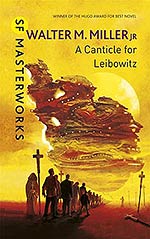
![]() icowrich
icowrich
11/5/2011
![]()
A Canticle for Leibowitz is one the few science fiction novels elevated to the status of high literature by the literati, even as they relegate the rest to us hoi polloi. Miller's first (and almost only) novel rightly belongs on the shelf next to George Orwell and Aldous Huxley. Like 1984 and Brave New World, Canticle is a negative utopia, but unlike either of them, this novel does not exist to point out the dangers of any one extreme, but to weave together an ironic tale of a society which slowly meanders from one extreme to another so as to illustrate how one state of affairs ultimately leads to its opposite.
Miller served in the Italian theatre during World War II, participating in the infamous shelling of Montecassino, a monastery built by St. Bennedict in the 4th century. The shelling devestated the ancient structure, which had also been repeatedly destroyed and rebuilt in previous centuries.
This book is Miller's penance.
The cyclical nature of Montecassino's rise and fall was not lost on Mr. Miller, nor was the fact that the monastery was built upon the ruins of a Roman citadel that also had fallen. Over the millenia, Montecassino saw glory and decline several times, much like the history of the western world.
The book is divided into three sections that mirror western civiliation's own cyclical rise and fall. The first section, entitled Fiat Lux, is a post apocalyptic world that bears a striking resemblence to the middle ages. Here, we are introduced to the order of Liebowitz, a monastic community devoted to its founder. The monks take a long view concerning their namesake's canonization, as well as everything else in their lives. To emphasize this point, we meet Francis, a monk whose life reflects the values inherent in his time. Our visit with Francis is doomed to end, however, because the narrative shifts six hundred years into a Renaissance, and again to a scientific age. The shifts in surroundings are less jarring than the abrupt change in values exhibited by the world at large. One constant, however, is the attitude displayed at the order of the Blessed (and finally Saint) Leibowitz.
The anger with with Miller writes this book is famously recognized. What is less clear is exactly what Miller rages against. What appears to be a critique of ignorance might be a disguised defense of it, and a condemnation of dangers of knowledge. Perhaps, on the other hand, the real danger is only the use of knowledge. The one conclusion this reader can make is that Miller doesn't warn us any one element of progress, but of the process itself.
To describe the narrative further would be to give away too much. Suffice it to say that several of the voices in this novel may be Miller's, or may be your own. In fact, the lesson this novel teaches is too ambiguous not to depend on your interpretation. That is perhaps, what makes it great.
http://www.worldswithoutend.com